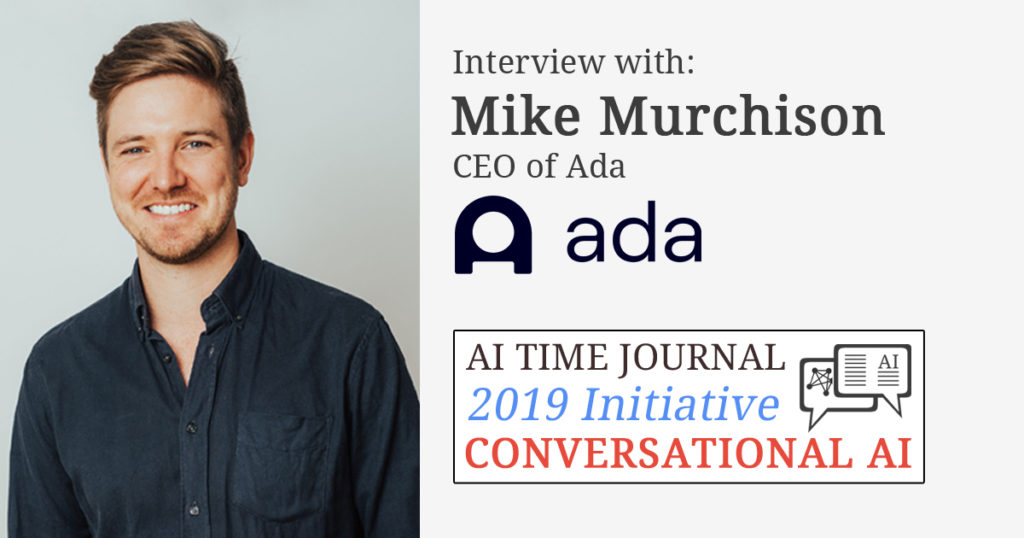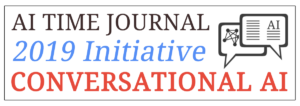
Mike Murchison is the CEO of Ada, a company that develops an AI-powered platform that empowers non-technical customer service teams to build a support chatbot that automates up to 80% of customer inquiries and delivers deep personalization.
In this interview, Mr. Murchison shares insights on how enterprises can leverage conversational AI to transform the role of support from a cost to a revenue centre.
This interview has been featured in the Conversational AI Initiative 2019.

What is your background and how was Ada started?
Before Ada, I led Volley, a social network that connected entrepreneurs with industry professionals.
As Volley grew, we encountered the operational challenges of scaling high-quality customer service. We had been manually answering every customer inquiry, a time-consuming, repetitive role that made us realize there had to be a better way.
I knew one experience wasn’t enough to truly empathize with the customer and agent. So, my co-founder David and I jumped aboard seven businesses as remote agents to manually answer ten thousand phone calls and emails. We wanted to understand the human and technological challenges preventing customer service from being incredible.
This experience allowed us to see firsthand the benefits automation would bring to the outdated industry. But more importantly, it allowed us to understand the need for technology to be simple enough for support teams – away from IT – to build the automated experience with knowledge, empathy, and speed. And we set out to build Ada’s AI-powered customer service platform.
Three years later, we’re proud to have emerged as the market leader in Automated Customer Experience (ACX), with powerful technology and a proven ACX framework that is transforming the customer experience for industry-leading enterprises around the world.
What is Ada’s mission?
Our mission is to make customer service great for everyone. We are doing this by empowering businesses with an automation-first strategy that reduces wait times, improves customer satisfaction, and generates revenue for a department that has been deemed a cost-centre for far too long.
We don’t think about automation as an afterthought or band-aid. Instead, our chatbot is designed to act as the front line of a company’s customer service. Ada underpins the customer experience, leveraging integrations and APIs, to automate both answers and actions across the entire journey.
Walk us through Ada’s products, and what problems they solve.
At Ada, we’ve designed an AI-powered platform that empowers non-technical customer service teams to build a support chatbot that automates up to 80% of customer inquiries and delivers deep personalization.
Unlike other vendors in the market, Ada isn’t a point solution or add-on that augments an agent-first support strategy. We don’t think about automation as an afterthought or band-aid. Instead, our chatbot is designed to act as the front line of a company’s customer service. Ada underpins the customer experience, leveraging integrations and APIs, to automate both answers and actions across the entire journey.
The results of our customers’ experience are dramatic. Ada improves CSAT and reduces churn by delivering a time-saving, personalized experience that makes customers feel more valued and understood. And by dramatically decreasing the number of inquiries that require human support, Ada also increases efficiency, reducing overhead costs by the millions.
Most significantly, Ada customers have elevated the role and impact of their customer service teams. Using Ada’s proven ACX (Automated Customer Experience) framework, companies can transform their support organization from a cost centre to a revenue centre. By engaging customers with useful and tailored up sell, cross-sell, and payments, Ada’s chatbot is able to uncover new revenues — often without the need for live support.
What are the biggest challenges that you are currently facing at Ada?
With customer service becoming core to brand differentiation, companies in virtually every industry are confused about how best to address customer needs. The market for chatbots and conversational AI platforms has become particularly crowded and chaotic. Unfortunately, this has led many enterprises to make poor knee jerk decisions, without a broader strategic context.
For Ada, this means we have the added challenge of overcoming the noise created by other AI vendors and self-service solutions—but time is on our side. Through our customers and the results we’ve delivered, Ada has earned credibility and is emerging as a leader. Also, because we’ve designed our platform to remove the complexity of introducing AI, our customers are able to realize quick wins and they can swiftly double down on a thoughtful automation-first strategy.
How do you measure the performance of your products?
We support our clients not only in building and launching their chatbot but also in managing the automated experience and maximizing its results. To make sure we’re helping them reach their goals, we track client success and chatbot performance in 3 ways:
CSAT: Level of satisfaction customers experience after an automation-first experience with Ada.
Savings: Deflecting phone calls and live chat sessions, as well as agent productivity improvements.
Revenue: Generated through automated upsells and cross-sells that are a natural extension of the customer service journey.
Tell us about the Ada team.
Based in downtown Toronto, the AI-capital of the world, our team of Ada Owners has increased from 2 to almost 150 people, in just three years. While we’re ramping quickly, we remain true to our core values of authenticity, empathy, simplicity and courage – that lead us in the way we work together and build our platform.
From agents to customers, and chatbot builders, we know our platform is engaged by a diverse group of people, and we’re focused on creating a team that reflects these users, with a diversity of backgrounds, thinking, and career experience.
For me, it’s really important that every Owner feels committed to their craft and that they’re empowered to do their best work. Together, we’re setting the foundation for a generational company that’s transforming the customer experience for millions, soon to be billions of people around the world.
We’ve purpose-built our platform so non-technical customer service professionals, the people who know the business best, can build and launch a chatbot that solves 30% of customer inquiries in less than 30 days.
What is your experience with voice-enabled interfaces?
While Ada is currently a messaging-based automation platform, we’re aware that voice continues to serve as an instrumental customer service channel. As one of the outdated support strategies needing to be addressed, we believe voice is certainly ripe for the benefits of AI-powered automation.
Ada integrates with many of our enterprise clients’ existing IVR solutions to deflect customer calls from reaching agents, by providing them with the option to use a self-service chatbot, rather than waiting on hold.
What opportunities do voice-enabled interfaces bring for enterprises?
Just as with an automated customer service chatbot, voice-enabled interfaces introduce new efficiencies that benefit both the agent and customer.
Introducing voice capabilities across new channels provides customers with additional self-service avenues for getting answers and taking action. This ultimately increases the number of inquiries deflected from reaching live agents, which we know saves overhead costs and preserves agent time for more meaningful conversations.
How can enterprises get started with their conversational AI strategy?
While many enterprises expect that introducing AI-powered customer service will be both time and budget-consuming, we have a tried and tested approach that proves otherwise.
To start a conversational AI strategy, support teams first need to remove their dependence on IT to build and manage the automated customer experience—and that’s been our strategy from the start. With Ada, launching a chatbot that integrates with your existing systems doesn’t require a costly, multi-year plan or hiring in-house developers. We’ve purpose-built our platform so non-technical customer service professionals, the people who know the business best, can build and launch a chatbot that solves 30% of customer inquiries in less than 30 days.
With this being said, enterprises shouldn’t expect their chatbot to automate every customer answer and action from launch. Focus first on automating the repetitive inquiries that are wasting time for both customers and agents. Once these FAQ-type questions are being handled, you get a cleaner line of sight into more complex inquiries to automate next.
How can enterprises prepare for the changes in the industry brought by Conversational AI technology?
As automated self-service is further integrated across the customer journey, organizations can no longer depend on IT teams and in-house developers to build and manage support chatbots. They’re too costly, slow, and disconnected from the customer. After all, you wouldn’t ask your customer service team to solve your IT problems.
So who should own the automated customer experience and lead enterprises through the changes brought by conversational AI and an automation-first approach? An ‘Automated Customer Experience’ (ACX) department – a completely new team of customer service professionals dedicated to applying AI to day-to-day operations that drive efficiency and revenue.
To scale automation now and into the future, Ada clients have introduced some of the world’s first ACX departments with completely new roles and responsibilities focused on building, managing, and monetizing their automated support.
Just as the Internet and social media gave rise to digital teams in nearly every organization, the ACX department will soon be table stakes for customer service leaders. And it’s now time for enterprises to begin building their teams.
The biggest opportunity brought by conversational AI is the ability to transform the role of support from a cost to a revenue centre.
What are the biggest opportunities for enterprises to leverage Conversational AI?
Customer service has traditionally been viewed as a cost centre, dependent on the broader business to bail out its budget. Long wait times and impersonal live support continue to lower CSAT and lose customers, and mundane and repetitive inquiries continue to drive agent attrition—costing businesses millions.
With conversational AI, enterprises have the opportunity to reduce overhead costs by automating answers and actions that save both customers and agents time and effort. But the biggest opportunity it brings is the ability to transform the role of support from a cost to a revenue centre. Ada automates opportunities for up-sell and cross-sell, timed and tailored to every customer—leading to new purchases and profit.
By flipping the budget from a negative to positive, support can be transformed into a proactive, self-sufficient team.
How can enterprises leverage Conversational AI to make their customers happier and more satisfied?
A new generation of customers is seeking out companies that don’t require them to wait on hold to complete an action or get an answer. They want instant, support – and the more they can do on their own time and device, the better.
That’s why: to make customers happy, it’s no longer just about providing a basic FAQ point-solution on a single channel. Businesses must put automation as the first line of customer service across every available channel and at every touchpoint – from first greeting to final checkout. Not only does this satisfy customers by removing the need to speak with an agent first, but it allows them to save more time and energy with new opportunities for self-service.
But, making customers happier and more satisfied can’t be done with a generic automated experience. Even when they’re speaking with a chatbot or voice system, customers expect more than impersonal assistance. They want conversational AI that already understands who they are, their context, and accounts information before they ask a single question. The right platform, like Ada, can deepen the personalization of every conversation with proactive promotions and hyper-relevant responses that create a 1-to-1 experience for every customer.
Which Conversational AI-related technology trend do you think will have the biggest impact in your industry in the coming years?
As we’ve already experienced with our own clients, the rise of AI-powered self-service will continue to have the biggest impact on the customer service industry in the coming years.
As AI-powered platforms, like Ada, are further integrated into the customer journey with increasingly deeper levels of customization, high-quality support is quickly becoming synonymous with personalized self-service.
I think there will be a resulting consolidation of the customer experience, and Marketing and Sales departments will prioritize customer relationships in a different way. Customer service departments will drive a material share of revenue, and will, therefore, wield more influence in ensuring a meaningful, personalized customer experience.
